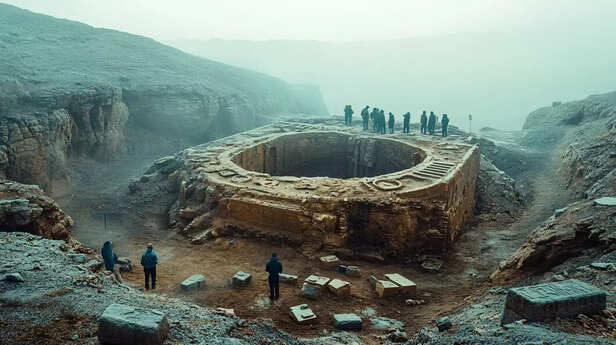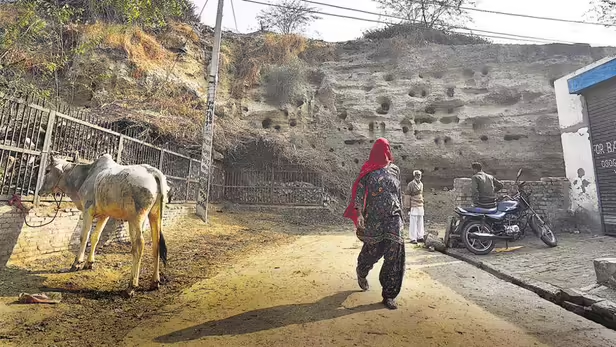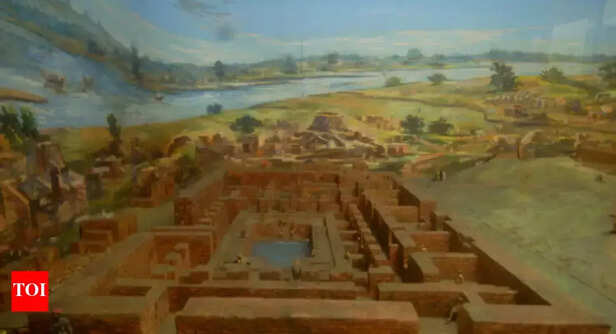Indus Valley vs. Invaders: Was the Fall Caused by the Arrival of the Aryans?
Nidhi | Jan 20, 2025, 23:04 IST
( Image credit : Timeslife )
The decline of the Indus Valley Civilization remains one of history’s great mysteries. This article examines the Aryan invasion theory, along with other explanations such as climate change, trade disruption, and internal political pressures, to provide a balanced view on what may have caused the collapse of this advanced ancient society.
The decline of the Indus Valley Civilization (IVC), one of the earliest and most advanced urban cultures of the ancient world, remains one of the greatest mysteries in archaeology. Known for its sophisticated cities, impressive trade networks, and advanced craftsmanship, the Harappan Civilization flourished for over a millennium. However, by around 1900 BCE, the civilization began to collapse. Various theories, including the Aryan invasion theory, have been put forward to explain this decline. In this article, we explore these theories, providing a fact-checked overview of the causes behind the fall of the Indus Valley Civilization.




The fall of the Indus Valley Civilization was likely a result of multiple factors, both internal and external. While the Aryan migration and cultural transformation played a role, it is clear that environmental changes, economic shifts, and internal instability also contributed to the decline. The decline of the Harappan cities was likely not caused by a single event but by a complex interplay of climatic, economic, and social forces.
The story of the Indus Valley’s collapse serves as a reminder that the decline of ancient civilizations is rarely due to a single cause. Instead, it often results from a combination of interconnected factors that shape the course of history. As we continue to study the past, the fall of the Indus Valley remains a fascinating case study in the complex dynamics of societal change.
The Rise and Legacy of the Indus Valley Civilization

Archaeological Site
( Image credit : Timeslife )
- Timeline:The Indus Valley Civilization, also called the Harappan Civilization, existed from around 3300 BCE to 1300 BCE. It was located in the region of present-day Pakistan, northwestern India, and parts of Afghanistan.
- Major Urban Centers:The civilization included well-developed cities like Harappa, Mohenjo-Daro, Dholavira, and Kalibangan. These cities were noted for their advanced urban planning, featuring grid-like street layouts, drainage systems, and well-constructed buildings.
- Trade and Craftsmanship:The Harappans were skilled artisans, producing high-quality beads, pottery, and metalwork. The civilization also had an active trade network, with evidence suggesting trade links with Mesopotamia, Persia, and other distant regions.
- Decline and Abandonment:Despite its success, the Indus Valley Civilization began to decline around 1900 BCE. By 1300 BCE, many of its cities were abandoned. The exact cause of the collapse is still debated, with theories ranging from natural disasters to external invasions.
How the Aryan Invasion Led to the Fall of the Indus Valley

Pakistan Archaeology Indus
( Image credit : Timeslife )
- The Aryan Arrival: Cultural ClashThe Aryan Invasion theory suggests that the Indo-Aryan tribes migrated into the Indian subcontinent around 1500 BCE from the steppes of Central Asia. These people are believed to have brought with them superior technologies such as horse-drawn chariots and iron tools, which some historians believe could have contributed to the downfall of the more peaceful Harappan society.However, this theory has been largely critiqued in modern scholarship. The idea that the Aryans overthrew the Harappans through violent warfare is now considered an oversimplification. Linguistic and genetic studies suggest that the Aryans did not invade suddenly but likely migrated gradually into the subcontinent, blending with the indigenous populations. Thus, while their cultural and technological contributions were significant, the fall of the Harappan cities cannot solely be attributed to this migration.
- Evidence of DestructionArchaeological sites such as Harappa and Mohenjo-Daro display signs of destruction, such as burnt buildings and signs of sudden abandonment. Some have linked this to an invasion or attack by the Aryans.While these signs of destruction do exist, the evidence is inconclusive regarding the cause. Some researchers argue that the Harappan cities might have suffered from internal social collapse, while others point to natural disasters, such as floods or earthquakes, as potential causes. The evidence for an Aryan-led invasion is not definitive, and the destruction of these cities may have been part of a broader, more complex process of decline.
- The Rise of Vedic CultureAs the Aryans settled in the Indian subcontinent, they introduced Vedic religious traditions, including ritual sacrifices, the development of the caste system, and an emphasis on agriculture. The Vedic culture marked a shift from the urban, trade-based society of the Harappans to a more agrarian and ritualistic society.This cultural transformation is likely to have contributed to the gradual decline of Harappan urbanism. However, rather than a violent takeover, this shift seems to have been more of an assimilation, with the Aryans adopting and blending with local customs and practices.
- Gradual Transformation vs. Sudden OverthrowThe decline of the Indus Valley Civilization was likely a gradual process rather than a sudden collapse. Evidence suggests that the cities of the Indus Valley were not destroyed in a single event but rather were abandoned over time. The migration of the Aryans and their cultural influence may have contributed to the region’s transformation, but it was likely one factor among many that led to the abandonment of Harappan cities.
What Other Theories Have to Say: A Broader Perspective

Rakhigarhi
( Image credit : Timeslife )
- Environmental Factors: Climate Change and River ShiftsOne of the most widely supported theories for the decline of the Indus Valley Civilization is that climate change and river shifts played a significant role. The Sarasvati River, which was central to Harappan agriculture and trade, began to dry up around 1900 BCE. This, coupled with a possible decline in monsoon rains, could have led to droughts, crop failures, and the eventual abandonment of cities.Geological studies support this idea, showing that the Sarasvati River underwent significant changes during the period when the Harappan cities began to decline. The resulting environmental stress could have made the region less habitable and contributed to the fall of the civilization.
- The Decline of Trade: Economic CollapseThe Harappans were heavily dependent on trade, both within the subcontinent and with regions like Mesopotamia. As trade routes shifted due to climatic changes and regional instability, the Harappan economy may have suffered. This loss of trade, particularly with distant regions, could have weakened the cities' economic foundations, leading to the abandonment of urban centers.Evidence shows that by 1900 BCE, trade with Mesopotamia and the Persian Gulf had declined, likely due to environmental and economic factors. The loss of these trade networks could have led to a gradual economic collapse and the eventual decline of the Harappan Civilization.
- Internal Collapse: Political and Social StrainThe Harappan Civilization lacked a centralized government, and its cities were likely part of a loose confederation of city-states. As the population grew and resources became scarcer, internal pressures such as social unrest, resource depletion, and regional competition may have contributed to the collapse.The movement of populations away from the urban centers suggests that there may have been internal political and social factors at play, such as the breakdown of trade or disagreements among city-states. While there is limited evidence for large-scale social unrest, the lack of centralized leadership made the civilization vulnerable to such challenges.
- Aryan Migration: Cultural Assimilation Rather Than InvasionRecent scholarship suggests that the Aryans did not invade the region in a violent manner but instead migrated gradually and assimilated with the existing populations. Genetic studies indicate that the Aryans contributed to the rise of the Vedic culture, but there was no large-scale destruction or military conquest. Instead, their migration likely intertwined with the existing societies, contributing to a gradual cultural transformation rather than an abrupt overthrow.
Conclusion: A Multi-Faceted Collapse

Indus Valley Civilization
( Image credit : Timeslife )
The fall of the Indus Valley Civilization was likely a result of multiple factors, both internal and external. While the Aryan migration and cultural transformation played a role, it is clear that environmental changes, economic shifts, and internal instability also contributed to the decline. The decline of the Harappan cities was likely not caused by a single event but by a complex interplay of climatic, economic, and social forces.
The story of the Indus Valley’s collapse serves as a reminder that the decline of ancient civilizations is rarely due to a single cause. Instead, it often results from a combination of interconnected factors that shape the course of history. As we continue to study the past, the fall of the Indus Valley remains a fascinating case study in the complex dynamics of societal change.
